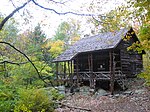The Kenilworth

The Kenilworth is a luxury 12-floor co-operative apartment building in Manhattan on the Gold Coast of Central Park West, located at 151 Central Park West, at 75th Street. Named for the 12-century Kenilworth Castle, construction on the residential building was completed in 1908, and was designed in the French Second Empire-style by architects Townsend, Steinle and Haskell, with three units per floor.The Kenilworth is located within the Upper West Side-Central Park West Historic District designated by the New York City Landmarks Preservation Commission, and is a contributing property to the federally designated Central Park West Historic District. Other Beaux-Arts apartment properties in this area of the same period include: The Prasada, The Langham, and The Saint Urban.
Excerpt from the Wikipedia article The Kenilworth (License: CC BY-SA 3.0, Authors, Images).The Kenilworth
Central Park West, New York Manhattan
Geographical coordinates (GPS) Address External links Nearby Places Show on map
Geographical coordinates (GPS)
| Latitude | Longitude |
|---|---|
| N 40.7785 ° | E -73.9747 ° |
Address
The Kenilworth
Central Park West 151
10024 New York, Manhattan
New York, United States
Open on Google Maps





